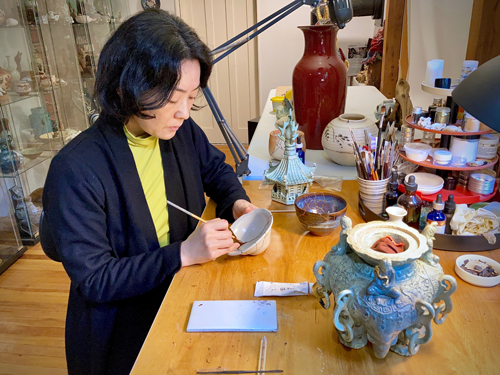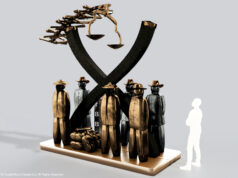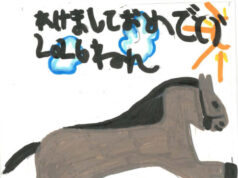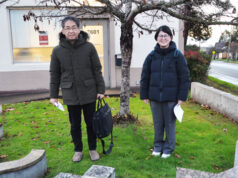Kintsugi: The Restorative Art of Naoko Fukumaru
By Will Lerner
NAP Contributor

Naoko Fukumaru working on kinstugi.
Portland Japanese Garden in Oregon is thrilled to present Kintsugi: The Restorative Art of Naoko Fukumaru in the Pavilion and Calvin/ Mayho Tanabe Galleries now through January 27, 2025. Kintsugi is a 500-year old Japanese method of mending damaged ceramics using urushi (natural lacquer) dusted with powdered gold. This timely exhibition will explore universal themes of healing through the artwork of kintsugi by artist and master conservator Naoko Fukumaru.
Fukumaru has over 20 years of experience as a professional ceramic and glass conservator at the Detroit Institute of Arts Museum in Michigan, Metropolitan Museum of Art in New York, and other institutions in the U.S., Europe, Egypt, and Japan. She was born in Kyoto, Japan to a four-generation antique auction house company, and grew up around artwork. Her work as a kintsugi artist is rooted in the belief that what is broken can be beautiful, and in the transformative power of healing spiritual wounds, as well as ceramic artwork.
“I first visited Portland Japanese Garden in November 2022,” said Fukumaru. “I realized that care and love are the main ingredients of this place. It was unmistakable that staff, volunteers, visitors, and all who were involved in this Garden were giving so much love, care, passion, and pride here. This truly resonates with my kintsugi artwork. This method of mending is seen as enhancing the beauty and value of objects by celebrating their imperfection and impermanence. This approach is the opposite of traditional Western ceramic restoration in which the damage to the work is sought to be hidden which I studied and practiced for 25 years.”
The Process of Making Kintsugi
“The kintsugi process is time-consuming—it takes several months to complete a piece. The first step is to reassemble the fragments of a broken object with Mugi-Urushi, which is made from wheat flour and water with urushi lacquer. Once reassembled, joints and chips need to be filled with Sabi-Urushi, which is made of stone powder, water, and urushi lacquer. The filler needs to be sanded to make a smooth surface. Then several layers of urushi lacquer are applied over the filler. Finally, gold powder is applied and polished up. It is important to let lacquer cure properly between each process for a few days or weeks, and curing also needs to happen in very specific humid and warm conditions.”
A Story of Healing
“I spend several months restoring each ceramic with care and love. When the owners are reunited with their kintsugi-restored ceramics, they are amazed at how the damage has transformed into beauty. Many tell me, ‘Wow, this is more beautiful than when it was complete. I am happy that the ceramic got broken.’ To me, this is extraordinary. I never heard this compliment in all my 25 years doing traditional Western ceramic restoration.
Because kintsugi does not hide damage, we can accept and celebrate mistakes and imperfections. People can overcome their traumas and sufferings when they realize they can find beauty in imperfection. Kintsugi teaches us how to forgive ourselves and others, and how to make a better world by applying its philosophy to everyday life. I am truly looking forward to sharing my stories and artwork with your community”
For more information, see: https://japanesegarden.org/.
Portland Japanese Garden is a nonprofit organization originally founded in 1963 as a place for cross-cultural understanding following World War II. A hallmark in the City of Portland, Oregon, the Garden was founded on the ideals of peace and mutual understanding between peoples and cultures. Portland Japanese Garden is considered the most authentic Japanese garden outside of Japan and the foremost Japanese cultural organization in North America.




